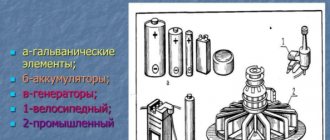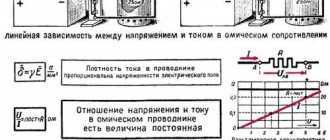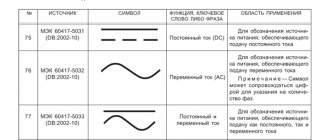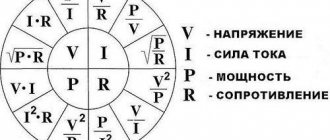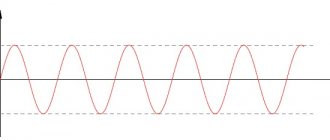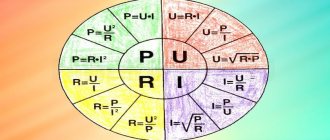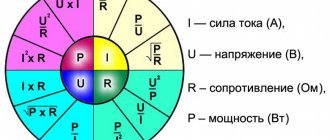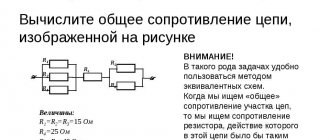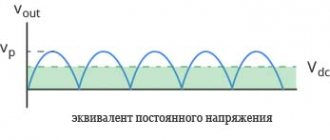Current is the movement of charged particles and is one of the key characteristics in an electrical circuit. This value is measured in Amperes. Electrical current measures the load on current-carrying wires, buses, and board traces.
Thanks to this value, you can understand how much energy flows in a conductor in a certain amount of time. The value can be calculated in different ways, depending on the data available.
Due to the fact that the solution options and known values may be different, you may encounter problems in the calculations. Next, let's look at how to correctly determine the current strength using different values.
Using power and voltage
If, of all the known data, you only have the value of power consumption and voltage, you need to use a simple formula that does not include resistance: P = IU
In this case, from the same formula you can get the following: I = P/U
This formula is suitable for a direct current circuit. And to calculate the current strength in circuits with alternating current (you may need this formula if you want to calculate the current strength in an electric motor), you also need to take into account the power factor (also called “cosine phi”).
In this case, for an electric motor with three phases, it is necessary to construct the calculation a little differently.
Find P, taking into account the efficiency: P1 = P2/η
In this formula, P 2 is the active shaft power and η is the efficiency. These values can usually be found on the engine itself.
After this, you need to find the total power taking into account the power factor (aka cos φ, its value is indicated on the engine): S = P1/cosφ
Next, determine the current consumption: Inom = S/(1.73 U)
1.73 is the root of three, this value is needed to calculate a three-phase circuit. The voltage value will depend on the method of switching on the electric motor (triangle or star) and Volts, most often 380.
Current calculation
The current value is calculated by power and is necessary at the design (planning) stage of a dwelling - apartment, house.
- The choice of power cable (wire) through which power consumption devices can be connected to the network depends on the value of this value
- Knowing the voltage of the electrical network and the full load of electrical appliances, you can use the formula to calculate the strength of the current that will need to be passed through the conductor (wire, cable). The cross-sectional area of the cores is selected based on its size.
If the electrical consumers in the apartment or house are known, it is necessary to perform simple calculations in order to correctly install the power supply circuit.
Similar calculations are performed for production purposes: determining the required cross-sectional area of the cable cores when connecting industrial equipment (various industrial electric motors and mechanisms).
By voltage or power and resistance
It also happens that to calculate the strength of the electric current, you need to use the voltage from a certain area or the magnitude of the load. Then the easiest way is to apply Ohm's law, which anyone who knows a little about physics knows.
If the voltage is unknown to you, but you know the value of power and resistance, carry out the calculation using the following formula: P=UI
Applying Ohm's law again, we get the following: U=IR
In this case: P=I2*R
We get the following formula: I2=P/R
In addition, you can apply the following calculation based on the same formulas and values: I=(P/R)1/2
Single-phase network voltage 220 V
Current strength I (in amperes, A) is calculated using the formula:
I=P/U,
where P is the electrical full load (must be indicated in the technical data sheet of the device), W (watt);
U – voltage of the electrical network, V (volts).
The table below shows the load values of typical household electrical appliances and the current they consume (for a voltage of 220 V) .
| electrical appliance | Power consumption, W | Current strength, A |
| Washing machine | 2000 – 2500 | 9,0 – 11,4 |
| Jacuzzi | 2000 – 2500 | 9,0 – 11,4 |
| Electric floor heating | 800 – 1400 | 3,6 – 6,4 |
| Stationary electric stove | 4500 – 8500 | 20,5 – 38,6 |
| microwave | 900 – 1300 | 4,1 – 5,9 |
| Dishwasher | 2000 — 2500 | 9,0 – 11,4 |
| Freezers, refrigerators | 140 — 300 | 0,6 – 1,4 |
| Electric meat grinder | 1100 — 1200 | 5,0 — 5,5 |
| Electric kettle | 1850 – 2000 | 8,4 – 9,0 |
| Electric coffee maker | 6з0 — 1200 | 3,0 – 5,5 |
| Juicer | 240 — 360 | 1,1 – 1,6 |
| Toaster | 640 — 1100 | 2,9 — 5,0 |
| Mixer | 250 — 400 | 1,1 – 1,8 |
| Hairdryer | 400 — 1600 | 1,8 – 7,3 |
| Iron | 900 — 1700 | 4,1 – 7,7 |
| Vacuum cleaner | 680 — 1400 | 3,1 – 6,4 |
| Fan | 250 — 400 | 1,0 – 1,8 |
| TV | 125 — 180 | 0,6 – 0,8 |
| Radio equipment | 70 — 100 | 0,3 – 0,5 |
| Lighting devices | 20 — 100 | 0,1 – 0,4 |
Using electromotive force, internal resistance and load
In some student textbooks there are so-called trick problems. These include those where there is an electromotive force and an internal resistance value.
Remembering Ohm's law, the strength of the electric current can be obtained as follows: I=E/(R+r)
Here E will be the electromotive force and r will be the internal resistance. R represents the load.
Equipment / Power tools, electricians and online calculators / Online calculator - Ohm's law (current, voltage, resistance) + Power
The reason for writing this article was not the complexity of these formulas, but the fact that during the design and development of any circuits it is often necessary to go through a series of values in order to reach the required parameters or balance the circuit. This article and the calculator in it will simplify this selection and speed up the process of implementing your plans. Also at the end of the article I will give several methods for memorizing the basic formula of Ohm’s law. This information will be useful for beginners. Although the formula is simple, sometimes there is confusion about where and what parameter should be, especially at first.
In radio electronics and electrical engineering, Ohm's law and the formula for calculating power are used more often than any other formula. They determine the strict relationship between the four most common electrical quantities: current, voltage, resistance and power.
Ohm's law. This relationship was discovered and proven by Georg Simon Ohm in 1826. For a section of a circuit, it sounds like this: current is directly proportional to voltage, and inversely proportional to resistance
This is how the basic formula is written:
By transforming the basic formula, you can find two other quantities:
Power. Its definition is as follows: power is the product of the instantaneous values of voltage and current in any part of the electrical circuit.
Formula for instantaneous electrical power:
Below is an online calculator for calculating Ohm's law and Power. This calculator allows you to determine the relationship between four electrical quantities: current, voltage, resistance and power. To do this, just enter any two values. Using the up and down arrows you can change the entered value in steps of one. The dimension of the quantities can also be selected. Also, for the convenience of selecting parameters, the calculator allows you to record up to ten previously performed calculations with the dimensions with which the calculations themselves were performed.
When we studied at the radio engineering college, we had to memorize a lot of stuff. And to make it easier to remember, there are three cheat sheets for Ohm’s law. Here are the methods we used.
The first is a mnemonic rule. If we express resistance from the formula of Ohm's law, then R = glass.
The second is the triangle method. It is also called the magic triangle of Ohm's law.
If we tear off the value that needs to be found, then in the remaining part we will get the formula for finding it.
Third. It is more of a cheat sheet that combines all the basic formulas for four electrical quantities.
It is as easy to use as a triangle. We select the parameter that we want to calculate, it is located in a small circle in the center and we get three formulas for its calculation. Next, select the one you need.
This circle, just like the triangle, can be called magical.
Using the Joule-Lenz law
Some find it difficult to determine the current strength if there is:
- Time;
- Resistance value;
- The amount of heat generated from the conductor.
To solve the problem, you need to use the Joule-Lenz law: Q=I2Rt
Based on this formula, the calculation should be constructed as follows: I2=QRt
Or like this: I=(Q/Rt)1/2
Calculation of power consumption
Electric power is a quantity that is responsible for the fact of the rate of change or transmission of electrical energy. There is full and active power load, as well as active and reactive. The total is calculated as follows: S = √ (P2 + Q2), where P is the active part and Q is the reactive part. To find the consumed power indicator, you need to know the amount of electric current that is consumed by the load, as well as the supply voltage that is supplied by the source.
As for the household determination of consumed electrical energy, it is necessary to calculate the total number of watts of power supply for electrical appliances and the passport data of the rated electric current of the boiler. As a rule, all electrical appliances operate with alternating current and a voltage of 220 volts. The easiest way to calculate current is to use an ammeter. Knowing the first and second parameters, it is possible to find out the amount of energy consumed.
It is worth pointing out that measuring power through voltage or calculating power from resistance and voltage is possible not only with a formula, but also with a device. To do this, you can use a multimeter with a current clamp or a specialized meter - a wattmeter.
Formula for calculating wire cross-section and how the wire cross-section is determined
Quite a lot of questions are associated with determining the cross-section of the wire when constructing electrical wiring. If we delve deeper into electrical engineering theory, the formula for calculating the cross section looks like this:
Of course, in practice, this formula is used quite rarely, resorting to a simpler calculation scheme. This scheme is quite simple: the current strength that will act in the circuit is determined, after which the cross-section is determined according to a special table. You can read more about this in the material – “Wire cross-section for electrical wiring”
Let's give an example. I have a 2000 W boiler, what size wire should it be to connect it to household electrical wiring? First, let's determine the current strength that will act in the circuit:
As you can see, the current strength is quite decent. We round the value to 10 A and refer to the table:
Thus, our boiler will require a wire with a cross-section of 1.7 mm. For greater reliability, we use a wire with a cross-section of 2 or 2.5 mm.
We recommend that you read:
Instruments for measuring quantities
Measurements of electrical quantities are made with special devices. Current is measured with an ammeter, voltage with a voltmeter, and power can be measured with a wattmeter, or calculated using a formula from the values of the first two values.
Using an online calculator, you can calculate not only the current at a known consumer power, but also the cross-section of the wires needed for electrical wiring.
Calculating the current strength and wiring parameters according to the power of electricity consumers is a very important part of the design of a building or apartment, so you need to approach this carefully and responsibly.
Types of capacities
Power is a measured physical quantity that is equal to the rate of change with the conversion, transmission or consumption of system energy. According to a narrower concept, this is an indicator that is equal to the ratio of time spent on work to the period itself spent on work. In mechanics it is designated by the symbol N. In electrical engineering the letter P is used. You can often also see the symbol W, from the word watt.
AC power is the product of current, voltage and cosine of the phase shift. In this case, only the active and reactive varieties can be easily counted. You can find out the full power value through the vector dependence of these indicators and area.
Main power types.

